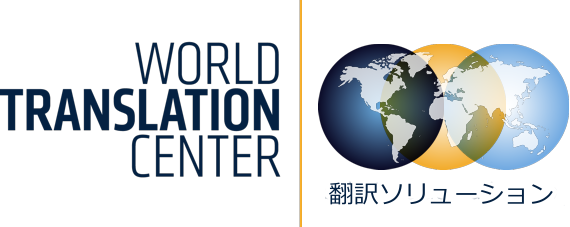WORLD TRANSLATION CENTERは、世界中の専門翻訳者による翻訳と音声録音サービスを提供する大手翻訳会社です。
Articles and Stories
Japanese Localization

Professional translators have always considered localizing their translation instead of simply translating it word for word, however, the term "localization" has only been around since the early 1990s.
In brief: Localization isn’t about simply translating words, it’s about translating culture. The Japanese culture is more formal than the western one and this formality is also reflected in any localization.
Localizing a Japanese project can be one of the hardest challenges when establishing a business relationship with Japan or introducing a product to Japan. A lot has to be considered before the start of a new project: there are three different writing systems, a huge vocabulary to choose from and many cultural differences that need to be discussed beforehand. You cannot take any text, brochure or video created in another country, have it translated and anticipate a perfectly localized version without addressing cultural differences.
Localization contains far more than simply translating, it requires a cultural understanding of the practices and of the country into which you are localizing. The localization process involves adapting any products or documents, including brochures, videos, software, applications, and websites for the local audience.
If a company wants to have a successful new entry into the Japanese market, it is important to consider all aspects that require localization as cultural miscalculations can have serious repercussions, as seen here with a few examples from around the world:
- When Pepsi expanded to the Chinese market, they used the great slogan, “Pepsi Brings You Back to Life”, however, the back translation of the translated Mandarin text then said “Pepsi brings your ancestors back from the grave.”
- Or in Italy, Schweppes Tonic Water was translated into “Schweppes toilet water”, definitely not something that you’d want to drink.
- When Gerber started selling their baby food in Africa, they used the same packaging as in the USA, with the cute baby on the label, but later they learned that, companies in Africa routinely put pictures on the label of what’s actually inside their package.
- Or do you remember JFK’s speech in Berlin when he said: “Ich bin ein Berliner”, which means “I am a doughnut”, or Hilary Clinton’s ‘reset’ button for Russia?
All instances should have been localized beforehand. World Translation Center offers to check company names and slogans around the world to make sure that such mishaps do not occur.
As mentioned above, to localize a project for the Japanese market it is important to understand all the cultural differences. Here are a few examples for your consideration:
- You should not use a non-Japanese face on a brochure to introduce a new cosmetic product for the Japanese market.
- You should not use the numbers 4 and 9 in your slogan as they are considered unlucky numbers due to the sound of their pronunciation. The Japanese word for ‘four’ sounds similar to the word for ‘death’, and ‘nine’ has the same pronunciation as ‘torture’ or ‘agony’. In many hospitals and hotels, there are no rooms with the number 4 or 9. If numbers are part of any presentation, then use the number ‘eight’ as it is considered a lucky number, the character strokes suggest ‘a better time or things to come’.
- Avoid the ‘ok sign as it means ‘money’ in Japan.
- Even choosing the right color for your logo and brochure is important to avoid catastrophic consequences, as colors can have different connotations in Japan.
Japanese font:
There are two ways of writing Japanese, vertically and horizontally. Nowadays, either is fine; most Japanese write horizontally but many newspapers and magazines still print vertically. One reason for the change from vertical to horizontal writing is because of the use of computers. It is, however, possible to write vertically on a computer with a Japanese operating system, but horizontal is the default setting for any word processor. For very artful brochures, you might want to discuss whether or not is it beneficial to use a vertical style.
The Japanese language is quite different from the English language in many ways: first the obvious, it sounds quite different than English and it uses a different font or alphabet. Actually, it uses three different alphabets — hiragana, katakana and kanji — which you mix when you write. Each alphabet has a distinct appearance and is used differently. The more you understand about the differences in culture, the easier it will be to adapt to it and to understand the localization process.
Here is a brief description the three different alphabets:
Hiragana
Each Hiragana character represents a sound. There are 48 different characters each represents a different sound.
Katakana
Katakana is also a syllabic alphabet, also with 48 different Katakana. Both the Hiragana and Katakana alphabets represent exactly the same sounds and some even look similar. Due to these sound characters, you do not have to remember how to pronounce a word as it is written in such a way that you understand how the word is pronounced.
The difference between these two alphabets is that Katakana is used for foreign words and Hiragana is used to represent native Japanese words.
Kanji
There are over 8000 characters in the Kanji alphabet. Kanji characters are used to represent abstract concepts as well as names and everyday words. An average adult Japanese speaker must know at least 2000 characters by heart. Kanji is a Japanese writing system based on borrowed or slightly modified Chinese characters.
Most Kanji characters have several meanings and pronunciations, which make translating even more difficult. Native Japanese speakers often do not know how to pronounce what the author intended. If that is the case, then Furigana is used for clarification, which is a Japanese reading aid, consisting of smaller syllabic characters that are placed next to a kanji or other character to show its pronunciation.
Japanese grammar:
The grammar is also quite different. The Japanese sentence structure is subject-object-verb, while in English is subject-verb-object.
‘I love to eat sushi’ turns into ‘I sushi eat love’.
This is important to know when dubbing a video where the speaker is on camera and the Japanese voice over has to sync the lip movement, such sentence structure makes it much harder than dubbing any other language. World Translation Center works with audio experts that understand how to adapt a translation to make it work for lip syncing. We also work with many voice talents who specialize in lip syncing. You can go to the Voice Center to listen to the voice demos or download them or we can suggest a speaker for your video.
Software localization:
Software or telephone systems have many English sentence fragments that require translation and possibly recording. Localizing such sentence fragments to make them play or display complete grammatically correct sentences on screen requires an English back translation including programming notes for the engineer to understand how to re-program a system for Japanese. Besides a different grammatical sentence structure, most of the time the font also needs to be encoded differently.
Business cards:
When traveling to Japan or hosting a Japanese delegation in your offices, it is important to have your business card localized into Japanese. Most of the time, the back side is used for the translation.
Most Japanese use the kanji alphabet to write their names, but hiragana is also used, especially for female names. There are thousands of kanji characters to choose from and there are many different kanji combinations that can be used for the same name. If you only hear a name, you will not know how to write it.
The exchanging of the Japanese business card can almost be considered ritualistic. It is wise to follow a strict business etiquette with business cards:
- Never slide or push your card across the table.
- Always accept a business card with two hands, then look at a card given to you and say thank you.
- It is also very bad taste to write on a business card or play with it. Consider each business card as an important treasure.
Business etiquette and appearance:
Politeness and good manners are the foundation of Japanese business etiquette just as they are anywhere else in the world. As mentioned above, the main difference is that the Japanese culture is more formal than the western culture.
You also need to localize your behavior when attending meetings with your Japanese business partners. The correct appearance is very important. A few examples of the difference:
- Do not wear a casual outfit, men should always wear dark suits and women should not wear pants.
- Do not point or use hand gestures.
- Leave the room if you have to blow your nose.
- Wear shoes that you can easily remove.
- When talking to a Japanese person, add the word ‘san’ to his or her first or last name. It is a title of respect added to a name. It is also used in emails or any other correspondence when writing a Japanese name in English. It can also be attached to titles to show respect.
The ultimate in localization:
The picture below of Hamlet dressed in Japanese clothes with a samurai, illustrates the ultimate in localization:

"Hamlet in the Graveyard." Illustration for Kanagaki’s adaptation of Hamlet.
Tokyo Eiri Shinbun November 13th, (1886)
This is just a short summary of some of the challenges that Japanese localization can present. As with any other language, using World Translation Center as your localization partner will turn your Japanese experience into a good one.







